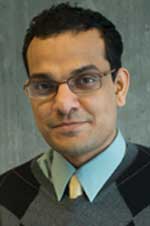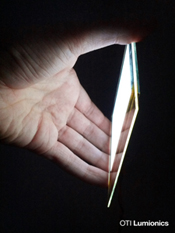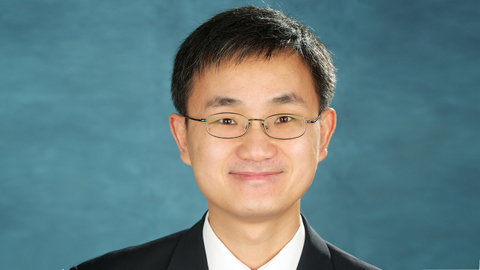Cancer; climate change; aging infrastructure; heart disease: these 50 letters can cost billions of dollars and countless lives.
On August 14, four U of T engineering students received Vanier Canada Graduate Scholarships – prestigious awards from the Government of Canada – to enable pioneering research in these areas:
- Miles Montgomery (IBBME PhD 1T6) for his work in heart disease and regenerative medicine;
- Cameron Ritchie (CivE PhD 1T6) for developing novel structural designs;
- Shrey Sindhwani (IBBME PhD 1T7) for breakthroughs in nanotechnology and cancer detection; and,
- Lorraine Sugar (CivE PhD 1T0) for her contributions to city-based climate action.
The awards were announced at an event at the University of Toronto, where 34 doctoral students and post-doctoral fellows from U of T garnered Vanier scholarships or Banting Postdoctoral Fellowships − the most of any institution in the country.
Biomedical engineering student Miles Montgomery, who hopes his work “will save people’s lives 20 years from now,” showcased his research on live, beating heart tissue at the announcement.
“Two hundred families are going to lose someone they love today – and the cost of heart failure to the health system will be an estimated $21 billion,” he said. “That’s the reason I come into the lab every morning ready to work.”
Before disclosing this year’s winners, the Honourable Ed Holder, Minister of State (Science and Technology) joined the Honourable Peter Van Loan (U of T alumnus and Leader of the Government in the House of Commons) to tour the cardiac tissue engineering lab led by Professor Milica Radisic (IBBME, ChemE). The lab is where Montgomery aims to overcome the challenges associated with creating an injectable patch of living, human tissue into patients with damaged hearts.
The Vanier Canada Graduate scholarships and Banting Fellowships were launched by the Government of Canada in 2008 and 2010 respectively to attract and retain world-class doctoral and post-doctoral talent.
“On behalf of the Faculty, I offer my warmest congratulations to Miles Montgomery, Cameron Ritchie, Shrey Sindhwani and Lorraine Sugar on this prestigious honour,” said Dean Cristina Amon. “With promising research in regenerative medicine, infrastructure, nanotechnology and climate change, these bright young researchers are a testament to the ambitious and innovative minds our engineering graduate programs attract.”
Considered the most prestigious awards of their kind, this year they represented a $34.7 million investment in research across the health sciences, natural sciences and engineering, social sciences and humanities.
“I’m proud that more than one in 10 of these awards has gone to the University of Toronto,” said Professor Locke Rowe, the University’s dean of graduate studies, who noted that U of T has received approximately 150 over the last five years. “These are core assets to the University and core assets to Canada.” View the full list of University of Toronto recipients.
View a photo gallery of the event.
 From the breakdown of natural wastes to the production of fossil fuels, many fundamental processes on Earth are performed by organisms too small for the eye to see.
From the breakdown of natural wastes to the production of fossil fuels, many fundamental processes on Earth are performed by organisms too small for the eye to see.
Professor Radhakrishnan Mahadevan (ChemE) specializes in the utilization of these vital micro-organisms, and this month his groundbreaking research landed him the Canadian Society for Chemical Engineering’s Syncrude Canada Innovation Award.
Professor Mahadevan’s innovative research in metabolic engineering, synthetic biology and bioinformatics – best understood as the collection and analysis of complex biological data – is internationally recognized. Applying recent advances in bioinformatics and bioengineering to significant real-world engineering challenges, his lab has developed complex computer models that accurately reproduce in silico all of the metabolic processes in a living organism. These sophisticated technologies illuminate the fundamental biochemical processes that underpin life, and can be used to develop new biotechnologies for a very wide range of sectors.
The goal of Mahadevan’s research is to engineer and optimize micro-organisms to efficiently perform chemical conversion processes for use in industrial and environmental applications. These include sustainable manufacturing of chemicals and materials from renewable biomass instead of fossil fuels, biological remediation of environmental pollution, biological pharmaceuticals production and the recovery of energy from waste streams using microbial processes.
Learn more about Professor Mahadevan’s Laboratory for Metabolic Systems Engineering.
The Syncrude Canada Innovation Award is presented to an individual under the age of 40 for a distinguished contribution to the field of chemical engineering while working in Canada. The award will be presented at the 64th Canadian Chemical Engineering Conference in Niagara Falls, ON, Oct 19-22, 2014.
Walk into a hardware store these days and you’ll find more varieties of light bulbs than ever before.
Some look strange and cost more than traditional incandescent bulbs, but these energy-efficient, “green” lighting solutions – and others still in development – are helping to drastically change our homes, our cities and our world.
Light emitting diodes (LEDs) are already starting to brighten up the GTA, while they reduce city energy bills. They dress up Toronto’s CN Tower with colourful, changeable, sustainable light displays – and they’re popping up in more day-to-day fixtures, too.
“Smart sustainable lighting is important,” said Elyse Henderson, special initiatives coordinator from the Smart Sustainable Lighting Network (SSLNet) at U of T’s Impact Centre. “Energy-efficient products are the easiest and cheapest way to combat climate change, rising energy costs and increasing energy demand.”
U of T Engineering alumni have sparked several sustainable lighting solutions, including successful startups such as: OTI Lumionics, a flexible organic LED manufacturer from alumni Michael G. Helander (EngSci 0T7, MSE PhD 1T2) and Xiaofeng Terry Xu (MASc MSE 1T2); and, Nanoleaf, the world’s most efficient light bulb, designed by Gimmy Chu (ElecE 0T6), Tom Rodinger (IBBME PhD 0T7) and Christian Yan (ElecE 0T6).
U of T News’ Brianna Goldberg met with two smart sustainable lighting pros – Henderson and Venkat Venkataramanan, director of scientific operations at the Impact Centre – to learn six important facts about the future of the light bulb, and how U of T engineers are making a difference.
LEDs are the “greenest” lights around – and older bulbs are so bad, they’re banned
EH: The traditional incandescent bulbs we all grew up with are so inefficient that their production has been banned by countries all over the world. Compact fluorescent lighting is energy efficient, but those bulbs contain toxic mercury, which makes them less environmentally sustainable. LEDs are the most energy-efficient form of lighting available, and their root in electronics makes them compatible with digital smart systems for homes and for public areas.
Imagine if the City of Toronto only had to change light bulbs every 10 years
VV: Outdoor lighting is one of the rapidly changing areas within the lighting sector. The City of Toronto estimates that it takes on average $200 to change a failed outdoor bulb, not withstanding traffic disruption. LED lighting devices have eight to ten times the life of the current technologies, significantly lowering the total cost of ownership. Besides, incorporating smart sensors helps collect vital data and perform energy analytics, condition monitoring and preventive maintenance of street lighting assets.
A world where lights themselves are the only ones worrying about lighting
EH: With the implementation of LED technology and adaptive controls, we will never need to manually adjust lighting levels or worry about lighting quality. Smart lighting systems will be working 24-7 to optimize energy usage, improving sustainability in the background of our daily lives.
A light that could improve health and happiness
VV: As we focus on optimizing energy savings, there is also a significant move towards creating more human-centric lighting. It has been well established that we perform better under different types of light during various hours in a day. While a sunlight-like spectrum of cool white light increases productivity during the daytime, a warmer incandescent light helps increase melatonin production ensuring a calm, good night’s sleep. U of T researchers are creating technologies that can enable an enriched spectrum of light.
Smart sustainable lighting could save the lives of thousands of birds
VV: Urban light pollution not only causes energy drain, Nature Ontario reports that approximately one million birds strike Toronto high-rise buildings annually, a greater fraction of which result in bird fatalities. Smart lighting helps deliver light where we want it, eliminating lighting pollution and reducing bird strikes on buildings.
Entrepreneurs from U of T are global leaders in smart sustainable lighting startups
VV: As lighting undergoes rapid transformation, the time is ripe for truly innovative companies to contribute significantly. U of T faculty and alumni startups like OTI Lumionics, Lumentra and Nanoleaf are all getting a lot of attention in the lighting community.
Find out more about the Impact Centre’s upcoming Smart Sustainable Lighting Network Conference & Workshop on August 18 – 20, 2014.
Whether you’re a Baby Boomer, a Gen Y or somewhere in between, your age group is characterized by its unique strengths, weaknesses and impacts on society. The current cohort, born after 1995 and dubbed “Generation Z,” have been heralded in Maclean’s Magazine as potentially “the most ambitious yet.” Now, as they navigate high school and pursue higher education, parents and educators explore novel and enticing ways to enable these forward thinkers with skills to address the challenges bestowed upon them by prior generations. U of T’s Da Vinci Engineering Enrichment Program (DEEP) hopes to do just that, tasking high-school students – now Gen Zs – with hands-on, team based challenges that give insight into engineering at the university level. Instructor Patricia Sheridan (BASc 0T9, MASc 1T1), PhD student at the Institute for Leadership Education in Engineering (ILead), teaches a course titled “Leading Engineering Innovation: Strategies for Success,” at DEEP. An alumna of the program herself, Sheridan discusses the importance of enabling this unique generation to be effective leaders and team members with U of T Engineering.
Why do you think skills like teamwork and leadership are important for engineers?
We live in a highly interconnected world where the challenges that engineers will face are larger, more complex and have more significant social impact than ever. It is vital for them to know what is important to them as individuals and as engineers, and what their personal value is in order to sell themselves and find areas for personal improvement. Focusing these students early on at seeking an area at the intersection of their skills and passions will give them a great head start in discovering what they want to do and what to look for in teammates and collaborators.
Would you agree with Maclean’s Magazine on their outlook that this generation is the most ambitious yet? What leadership strengths have you seen in the DEEP cohort this summer?
The students are so mature, intelligent, and self-aware; it is very rewarding to work with them. The amount of energy and passion they have for what they are interested in really stood out to me. Many stayed back to finish conversations that were started in class, to ask more questions about the topics or to learn more about Engineering at U of T. The questions they asked were very thoughtful, and demonstrated an interest in the subject matter as well as in the value that my answer could provide them.
As a DEEP alumna, can you share with us how the program helped you as a young engineer?
It was important for me to get involved in DEEP as it was an instrumental part of my decision to come to U of T when I was a high school student. Participating in DEEP gave me the opportunity to see the campus, see the types of students and professors that were here and gave me a feel of whether I would fit into the environment or not. I think having this type of opportunity to experience first-hand what a brochure cannot fully capture is an essential part of gathering all the information needed to make an informed decision about which program and university to attend. When I participated in DEEP I saw a high caliber of intellectual, fun-loving and sociable people that I felt I would fit right in with, and, I have, since I came to this university.
What advice do you have for young (future) engineers?
Go out and try new things—you have to see how they feel to know if they work for you! Be open to ambiguity, not getting an answer, or not finding a right answer. The world is not a binary place of right and wrong like high school tests. Find out more about yourself, find out what matters to you, and find ways to live in that space and embrace the ambiguity of the parts you don’t know. Offered over four weeks in the summer months, the Faculty’s Da Vinci Engineering Enrichment Program (DEEP) lets high school students with an aptitude for science and math get a closer look at Engineering at U of T before they even apply. Taught by graduate students in the Faculty, DEEP provides young people from around the world with the opportunity for advanced study in a variety of engineering, technology, business and science disciplines. For more information on DEEP Summer Academy, please visit the Engineering Outreach website.

With the latest LED technology, tomorrow’s televisions and smartphones are set to be thinner and more flexible than ever. And now, thanks to a startup from U of T Engineering alumni, they could be more affordable as well.
OTI Lumionics is one of 11 startups – two of which hail from Engineering – that recently completed U of T’s elite accelerator program, Creative Destruction Lab, based at the Rotman School of Management.
The fledgling enterprises spent the last eight months developing various technical and business aspects of their companies, while meeting with Canadian business and entrepreneurship titans. The Lab focuses on preparing ventures for success, as well as connecting them to early-stage investors.
With two cohorts graduating from the program so far, the Lab claims that graduated ventures have already collectively generated approximately $130 million in equity value (value of a company to owners or shareholders).
“We are excited to see how much the second cohort of ventures has grown since they first applied back in September 2013,” said Jesse Rodgers, director of the Lab. “We had an increase in both the overall quality and quantity of applications this year, and it was really great to see eleven ventures successfully complete the program.”
Learn more about two of this year’s Engineering-related startups:
 OTI Lumionics
OTI Lumionics
Forget your clunky television, tablet or smartphone. With organic light-emitting diodes (OLEDs), digitals displays can be as thin and flexible as a sheet of paper.
U of T Engineering alumni startup OTI Lumionics is working on unlocking the full potential of OLEDs through innovative equipment, materials and processes.
OTI president Michael G. Helander (EngSci 0T7, MSE PhD 1T2), development vice-president Xiaofeng Terry Xu (MASc MSE 1T12) and their team are reducing the cost of OLED technology. This could open up new possibilities for use across a wide array of industries, including lighting, displays, solar cells and more.
“Our patented solutions eliminate the bottleneck in traditional OLED manufacturing, enabling low-cost and high-volume mass production,” reads the company’s website.
 Whirlscape
Whirlscape
You wouldn’t want a keyboard blocking half your desktop screen – so why do we put it with it for our smartphones and tablets?
Minuum, developed by the startup Whirlscape, is a tiny intelligent keyboard that takes up a fraction of the space on portable electronics. Predicting text with high accuracy, the single-line keyboard blasted beyond its Indiegogo crowdfunding campaign by 873 per cent.
Two of the company’s three co-founders come from U of T Engineering: Xavier Snelgrove (EngSci 1T1) and William Walmsley (MASc MIE 1T2).
“It’s really about the user’s expectations of the keyboard,” Walmsleytold online magazine The Verge. “Most of the frustration that happens when you’re using an iPhone keyboard is because you’re shown these distinct buttons, and you feel like you’re supposed to use it like a typewriter where you need to hit every button every time.
“But that’s completely unrealistic, because when you’re using a phone that’s that small, you’re going to be making mistakes all the time anyway. So by making the keys even smaller, really we’ve changed the user’s mindset to be aware that they’re supposed to miss every time… it’s the understanding that the system is always working with them to correct their spelling.”
[youtube https://www.youtube.com/watch?v=niV2KCkKmRw]
Read more about this Creative Destruction Lab cohort’s 11 startups.
About the Creative Destruction Lab
Founded in 2012 by ProfessorAjay Agrawal, the Creative Destruction Lab at the Rotman School of Management leverages leading faculty and industry networks, inventions, and talent from world-class, technology-oriented faculties at the University of Toronto as well as its location in Toronto, one of the world’s most culturally diverse cities and Canada’s largest financial centre.
The Rotman School of Management at the University of Toronto is redesigning business education for the 21st century with a curriculum based on Integrative Thinking. Located in the world’s most diverse city, the Rotman School fosters a new way to think that enables the design of creative business solutions.

in the world.
Want faster Internet? Professor Wei Yu (ECE) is on the case.
Professor Yu was recently named to Thomson Reuters’ rankings of the most highly cited scientific researchers in the world, one of 19 University of Toronto professors to make the list. He was included in the Computer Science category, which selected just 117 top thinkers from around the globe.
“I’m drawn to research in communication theory, both because of the beauty of the mathematical theory of communications, and because the enormous practical impact communication technologies have had in our society,” said Professor Yu. “This is a rare combination that makes scientific pursuits in this area so rewarding.”
Professor Yu’s research focuses on information theory and wireless communications, and he is the current Canada Research Chair in Information Theory and Wireless Communications. His work aims to develop systematic tools for the design, analysis, and optimization of wireless cellular systems. Professor Yu has published several highly cited research papers devoted to uncovering the fundamental capacity limits of communication scenarios, so as to derive insights that propel and evolve the future of wireless networks.
According to Google scholar citations, Professor Yu has received almost 10,000 citations.
Thomson Reuters is a multinational data and media company. It selected its most influential researchers by considering “highly cited papers,” definted as “those that rank in the top 1% by citations for field and year indexed in the Web of Science.” Learn more about their methodology.
